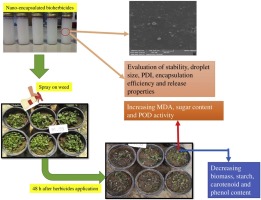Industrial Crops and Products ( IF 5.6 ) Pub Date : 2020-03-25 , DOI: 10.1016/j.indcrop.2020.112348 Azin Taban , Mohammad Jamal Saharkhiz , Mohammad Khorram

|
Excessive uses of chemical pesticides have resulted in the occurrence of a wide array of problems consequently using plant natural products is gaining more attention. In this study, different concentrations of savory (Satureja hortensis L.) essential oil (control, 5, 10 and 15 ml/L) were nano-encapsulated using Arabic gum (AG), Persian gum/gelatin (PGG), Persian gum (PG) as wall materials. The nanocapsules had their herbicidal activity against tomato (Lycopersicon esculentum Mill.) and amaranth (Amaranthus retroflexus L.) evaluated by measuring 18 physiological and biochemical parameters. The average size of the nanocapsules varied between 81 and 208 nm, while polydispersity index showed variation between 0.210 and 0.536. The encapsulation efficiency of nanoparticles varied between 72.1–92.8 %. Nano-encapsulated herbicides (NCHs) stability was investigated for 42 days and a mathematical model was followed during oil release. Nano-encapsulated herbicides showed considerable herbicidal activity against amaranth while they had a mild effect on tomato. Moreover, herbicidal activity results exhibited the improvement of encapsulated savory essential oil (EO) efficiencies as compared to non-nano EO emulsion (without polymer). The greatest and fastest injury to amaranth caused by encapsulated EO using cross-linked Persian gum at 15 ml/L which asserted 100 % weed control after 48 h. The aforementioned data suggest the encapsulation of essential oils by biopolymers and with the help of cross-linkers can be used as a valuable tool for the production of organic, natural herbicides.
中文翻译:

基于生物聚合物和精油的纳米胶囊生物除草剂的配制和评估
化学农药的过量使用导致了各种各样的问题的发生,因此使用植物天然产物引起了越来越多的关注。在这项研究中,不同浓度的咸味(的香薄荷属菠菜L.)的精油(对照,5,10和15ml / L)使用阿拉伯树胶(AG),波斯胶/明胶(PGG),波斯胶(纳米囊封PG)作为墙体材料。纳米胶囊具有对番茄(Lycopersicon esculentum Mill。)和a菜(Amaranthus retroflexus)的除草活性。L.)通过测量18个生理和生化参数进行评估。纳米胶囊的平均尺寸在81至208nm之间变化,而多分散指数显示在0.210至0.536之间变化。纳米粒子的封装效率在72.1%至92.8%之间变化。纳米封装的除草剂(NCHs)的稳定性研究了42天,并在油释放过程中遵循了数学模型。纳米封装的除草剂对an菜具有相当大的除草活性,而它们对番茄具有温和的作用。此外,与非纳米EO乳液(不含聚合物)相比,除草活性结果显示出封装的香精油(EO)的效率得到了提高。使用交联的波斯树胶以15 ml / L的浓度包封的EO对a菜造成的最大,最快的伤害是48 h后100%的杂草控制。前述数据表明,生物聚合物对香精油的包封作用以及在交联剂的帮助下可用作生产有机天然除草剂的有价值的工具。











































 京公网安备 11010802027423号
京公网安备 11010802027423号